AB Sciex TOF/TOF
The AB Sciex TOF/TOF instruments are unusual in that the spectra are stored in an Oracle database, rather than "raw" files. There are several options available for searching TOF/TOF data with Mascot Server and it is possible export data to mzML, which enables Mascot Distiller to be used for quantitation.
AB Sciex GPS Explorer can be used to submit searches direct to an in-house Mascot Server.
TS2Mascot is a free utility that extracts a peak list from the Oracle database and loads it into the Mascot search form in a web browser. This can be convenient for an iTRAQ quantitation experiment.
MS Data Converter is the AB Sciex command line utility to export data in mzML and MGF formats. An MGF file is the most compact format for submission to Mascot. The mzML format is more verbose, but has the advantage that it can be opened in Mascot Distiller for searching, de novo sequencing, and quantitation. For searching batches of files, the MS Data Converter can be used as a data import filter in Mascot Daemon 2.5 and later.
AB Sciex GPS Explorer
AB Sciex provide two software packages to support their TOF/TOF instruments: 4/5000 Series Explorer and GPS Explorer. In addition, individual spectra can be exported as *.T2D files and opened by Data Explorer or Mascot Distiller.
GPS Explorer includes extensive Mascot integration. Search parameters are defined as part of an Analysis in GPS Sample Setup. On completion of each search, the results are imported into the 4000 series database and can be viewed and reported using the GPS Results Browser. The workflow supports both ICAT® and iTRAQTM quantitation.
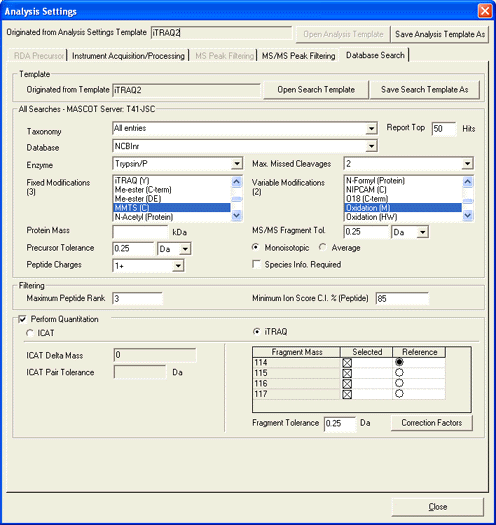
If you wish to submit a search from a web browser using the Mascot search form, the 4/5000 Series Explorer has a function called Peaks to Mascot that exports a peak list to an MGF file.
TS2Mascot
A free utility called TS2Mascot provides a convenient way to submit a search through the standard Mascot search form. This is a Windows program that communicates with the Oracle database using ODBC. The PC will need to have Oracle client software installed, including the Oracle ODBC driver. To submit a Mascot search from TS2Mascot, Microsoft Internet Explorer 4.01 SP2 or later must be installed and operational.
To install TS2Mascot, run the TS2Mascot installer. Unless 4000 Series Explorer or GPS Explorer is already installed on the target PC, you may need to create a local Oracle service name, as described in the setup instructions.
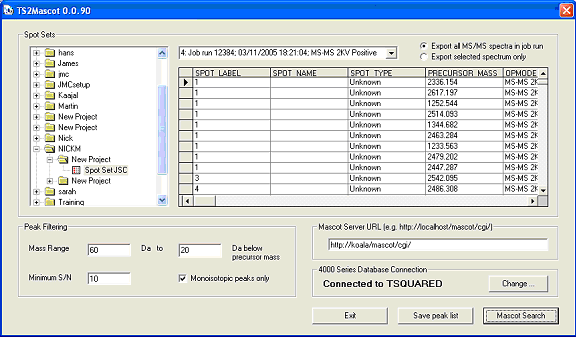
TS2Mascot is very simple to use. It is launched from the Windows Start menu, (Programs; Mascot; TS2Mascot). The folder tree in the Spot Sets frame is populated with project folders from the 4000 series database. If you have more than one 4000 series database, choose Change to connect to a different database. Navigate the folder tree and select a spot set icon. This will populate the adjacent drop down list with the job runs for the spot set. The grid area displays details of individual job run items for the selected job run.
Peak filtering settings are equivalent to those used in AB Sciex GPS Explorer. The mass range limits only apply to MS/MS fragment ion peaks. The contents of the Peak Filtering and Mascot Server URL fields are sticky. If you change them, then process a spot set, the new values will be remembered. Save peak list invokes a standard file selection dialog before processing the data. Before choosing Mascot Search, ensure that you have entered a valid URL for a Mascot server. You can enter the URL of the Matrix Science public web site, but remember that this has a limit of 300 spectra in a single search.
While the peak list is being created, a progress bar is displayed, and all the controls are disabled apart from a Cancel button. Once peak list export is complete, if you have chosen Mascot Search, the default web browser will be launched and the Mascot MS/MS search form displayed. The search title and data file path are filled in automatically. The other settings are the search form defaults, (which can be customised by following a link on the search form selection page).
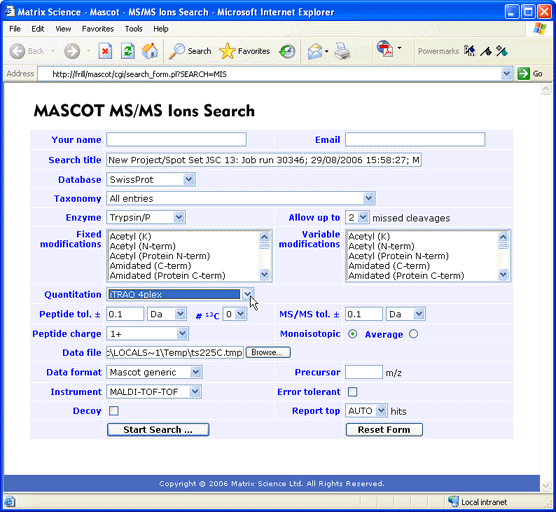
If you want to perform iTRAQ quantitation outside of GPS Explorer, it is important to use TS2Mascot because the peak areas in the peak list exported by Peaks to Mascot or submitted to a Mascot server by GPS Explorer are not quite the same as those required for quantitation. For a detailed description of Mascot support for iTRAQ quantitation, refer to the quantitation help page for the Reporter Protocol.
MS Data Converter
The MS Data Converter is a free download from AB Sciex. It supports both Wiff files and TOF/TOF data stored in an Oracle database. Output can be a simple MGF peak list or an mzML file containing a fairly complete representation of the raw data.
Note that the system requirements for MS Data Converter specify Windows XP or Windows 7 SP1. We have been unable to get it running on Windows 8 and later.
The MS Data Converter can be used as a data import filter in Mascot Daemon 2.5 and later. This enables batch automation of peak picking and search submission
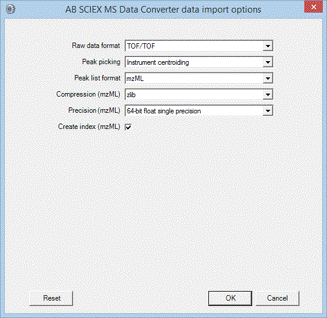
Converting a TOF/TOF spot set into an mzML file enables Mascot Distiller to be used for quantitation. Select the MS and MS/MS job runs corresponding to a single LC separation. If you have multiple separations, corresponding to fractions or replicates, each one must be exported to a separate mzML file, and you can then create a Distiller multi-file project for the set of files. The MS Data Converter User Guide explains how to format a path to specify the data to be exported. In most cases, you should choose to export profile data.
Once your data are in mzML format, Mascot Distiller can be used quantitation. Suitable Distiller processing options for profile and centroided MALDI data exported to mzML are here: mzml_profile_maldi.opt, mzml_centroid_maldi.opt.
If Distiller includes the optional Mascot Daemon Toolbox, Mascot Daemon can be used to automate peak picking, Mascot search, quantitation, and saving the Distiller project file. This screen shot shows an example of a SILAC experiment using data acquired on a 4800, courtesy of Ida Chiara Guerrera and Francois Guillonneau, Universite Paris Descartes.
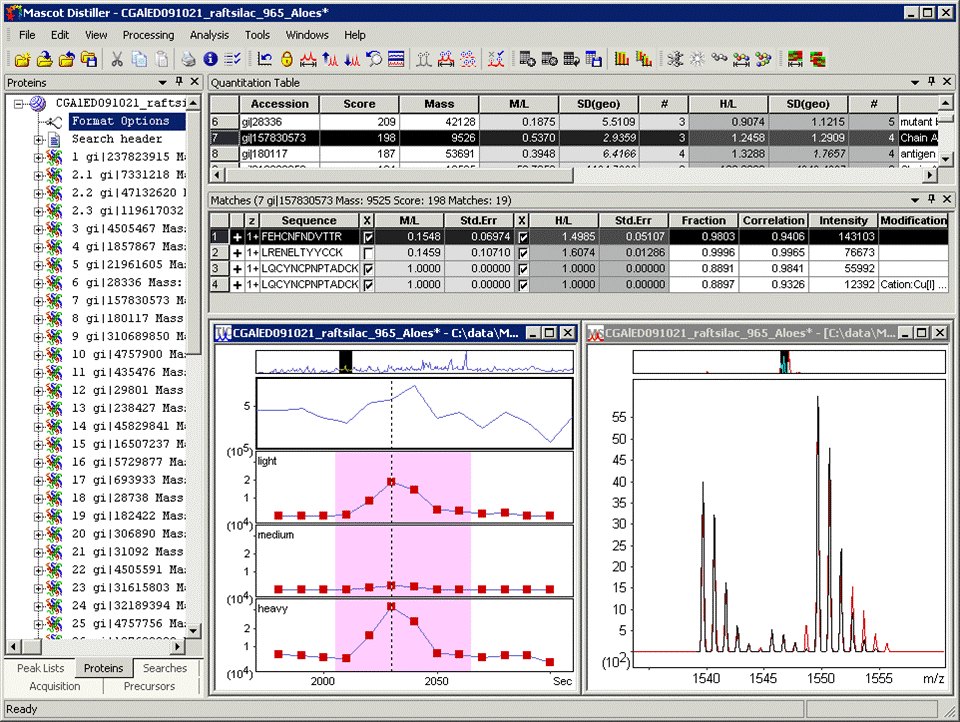
If you wanted to automate this procedure for a batch of experiments, this would require two Daemon tasks. The first to convert the spot sets to mzML files using MS Data Converter, the second to process the mzML files in Mascot Distiller.
All trade marks and service marks belonging to AB Sciex are hereby acknowledged.